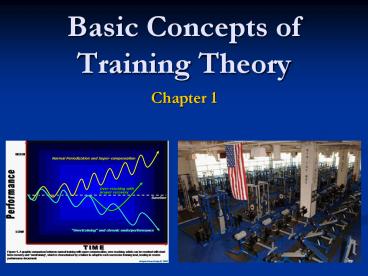Basic Concepts of Training Theory - PowerPoint PPT Presentation
1 / 27
Title:
Basic Concepts of Training Theory
Description:
Therefore, following workout: Fitness is enhanced. Performance is diminished (fatigue) ... Following a workout. Preparedness improves due to fitness gain ... – PowerPoint PPT presentation
Number of Views:484
Avg rating:3.0/5.0
Title: Basic Concepts of Training Theory
1
Basic Concepts of Training Theory
- Chapter 1
2
Training
- Involves strength and speed and all aspects
- Comprehensive
- Adaptation - adjustment of an organism to its
environment - Adaptation is ever changing
- Immediate vs. delayed effects
- Training should induce specific adaptations to
improve sports performance (SAID principle)
3
(No Transcript)
4
Adaptation Process
- Four features
- Overload
- Accommodation
- Specificity
- Individualization
- These are of primary importance for sport training
5
1. Overload (pg 4)
- Must be above the habitual level
- Increase intensity or volume (effort)
- Add new drills (variability)
- Load must be manipulated carefully
- PRE-Progressive resistance exercise
6
Figure 1.1
7
2. Accommodation
- Same exercises over long time
- Performance gains decrease
- Prolonged stimulus
- Principle of diminishing returns (response)
- Training long periods may show accommodation
(gain decreases) - Sport specificity (variable vs. stable?)
8
Figure 1.2
9
3. Specificity
- Transfer of training results
- From exercise to sport
- From exercise to exercise
- Carryover effect
- Training age?
10
Figure 1.3
11
The gravitational force between two objects is
proportional to the product of their masses and
inversely proportional to the square of the
distance between them. (Universal Gravitation)
12
4. Individualization
- Everyone is different
- Responders and non-responders
- Each program must be individualized
- Dont use others programs
- Pros are pros and were not!
13
Generalized Theories of Training
- Overall programs and not specific
- Serve as a model for training
- Used for planning programs
- They are simple and practical
14
One-factor Theory (Supercompensation)
- Uses a depletion model
- Accounts for athletic preparedness (how much)
- Muscle glycogen depletion?
- In Restoration the level returns to normal
- Supercompensation is the increase over normal
- Rest is the forgotten variable (FIVR)
15
Figure 1.4
16
Hans Selye, MD, PhD 1907-1982
17
Rest Intervals
- Optimal rest!
- Subsequent workouts coincide with
supercompensation - Timing is important
- The timing of the event may be more important
than the event itself
18
Figure 1.5
- (a) Too little
- (b) Just right
- (c) Too much
19
Overloading Microcycle
- Several short rest periods followed by long rest
- Supercompensation is enhanced
- Nutrition must also be included
- Carbohydrate loading for supercompensation
- Glycogen stores are enhanced but ATP appears
unaffected
20
Figure 1.6
21
Two-Factor Theory (fitness-fatigue theory)
- Preparedness is both slow and fast changing
- Physical Fitness is slow changing
- Performance is fast changing
- Fatigue
- Overstress
- Sickness
- Therefore, following a workout
- Fitness is enhanced
- Performance is diminished (fatigue)
22
Preparedness
- Following a workout
- Preparedness improves due to fitness gain
- Preparedness decreases due to fatigue
- Summation of and equals outcome
- Fitness is moderate but long lasting
- Fatigue is greater but short lasting
23
Figure 1.7
24
Training Models
- An organized process rather than chaos
- Peaking is reaching your max
- Tapering is rest
- Reduce the number of sessions or the load
(effort) - One-factor uses regular intervals
- Rest intervals are set
- Two-factor uses rest to determine next workout
- Next workout should come after negative effects
leave
25
Training Effects
- Acute during exercise
- Immediate right after exercise
- Cumulative after continued exercise
- Delayed (chronic) after a given time frame
- Partial single exercise training
- Residual retention after adaptation
26
Summary
- Induce specific adaptations
- Increase athletic performance
- Strength must improve
- Training load must be above normal (effort)
- Adaptation
- Overload
- Specific
- Vary over time
- Individualized
- Simple training models
- Supercompensation
- One-factor
- Restoration and increase
- Two-factor
- Fitness and preparedness
- Training effects
- Acute to residual
27
Next Class
- Lab tonight on torque power/velocity curve
- Single leg velocity spectrum (60, 180, 300, 400,
500) - Homework graphs and explanation
- Homework on AV Hill article
- Concentrate on pgs 177-178.
- Next week Chapter 2 and lab

